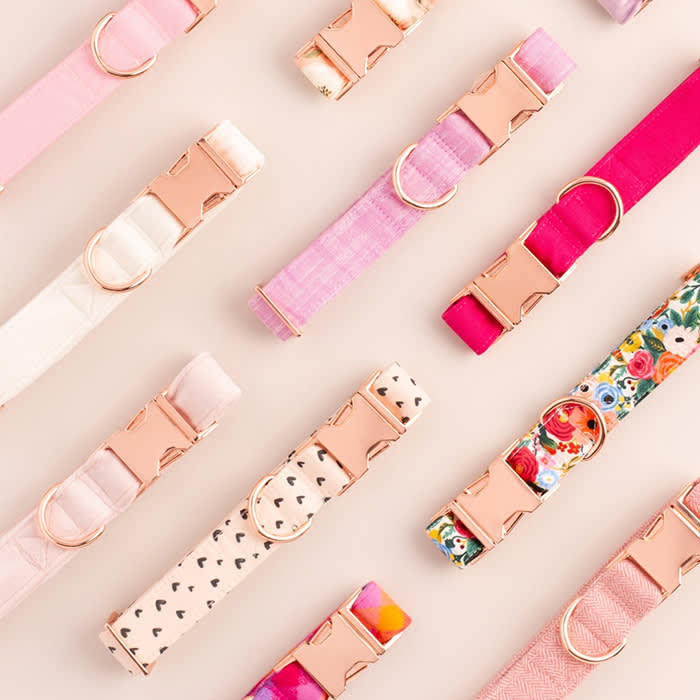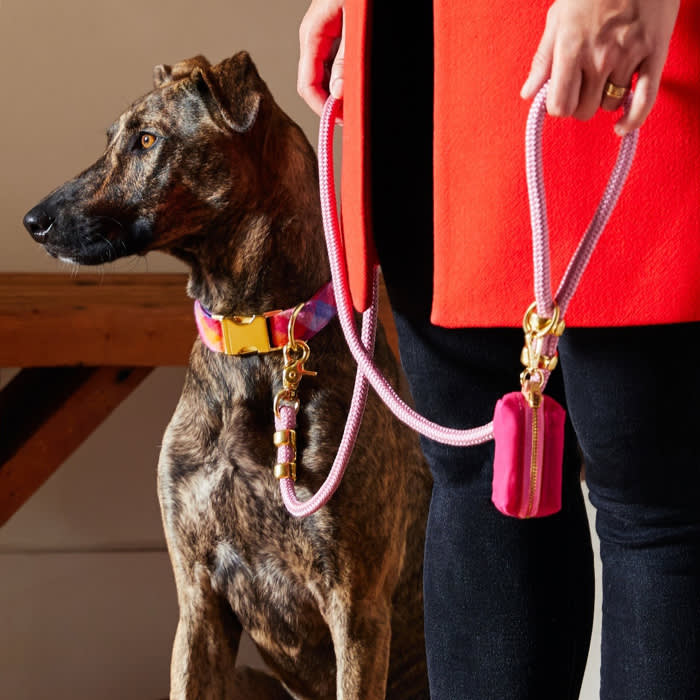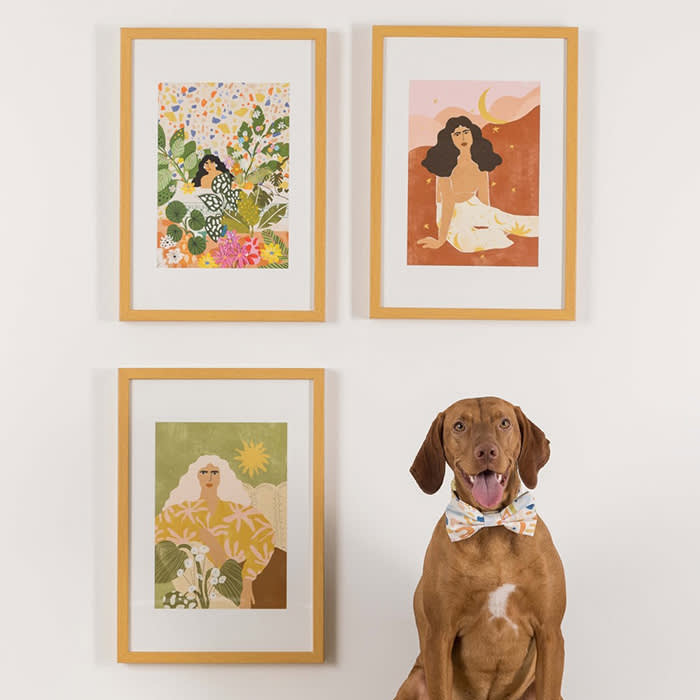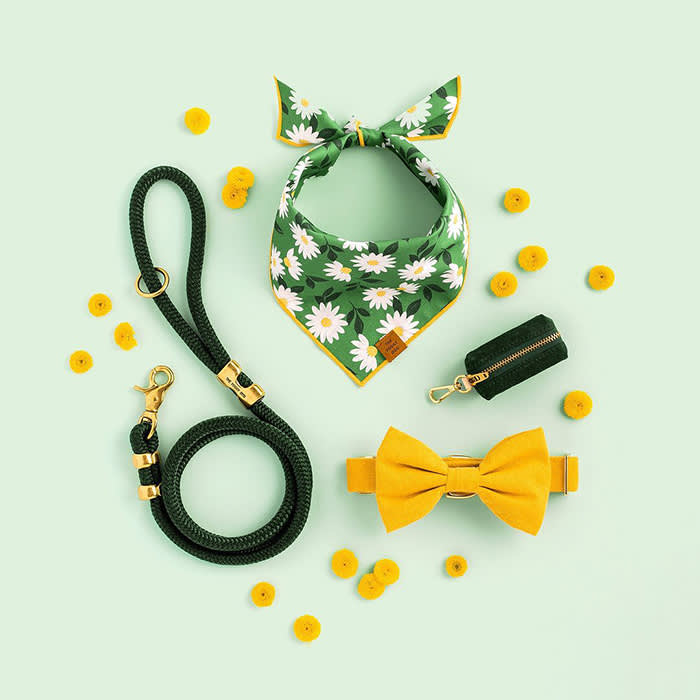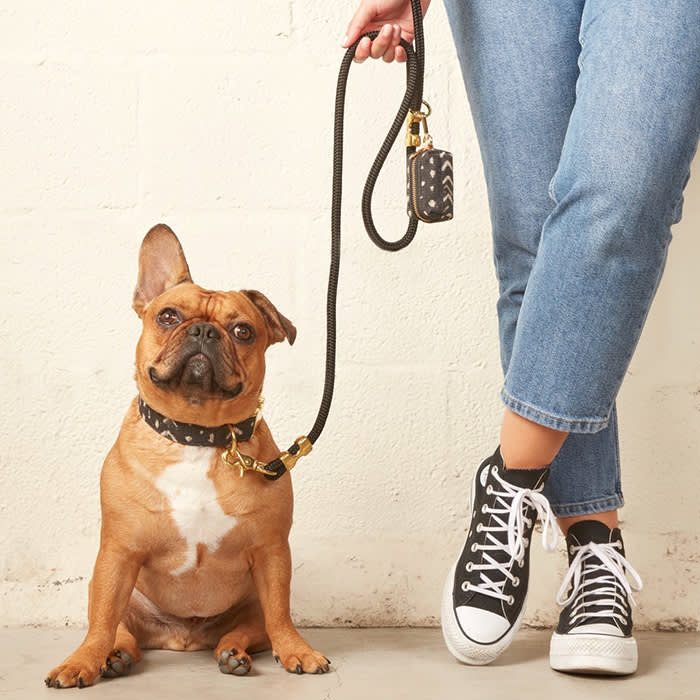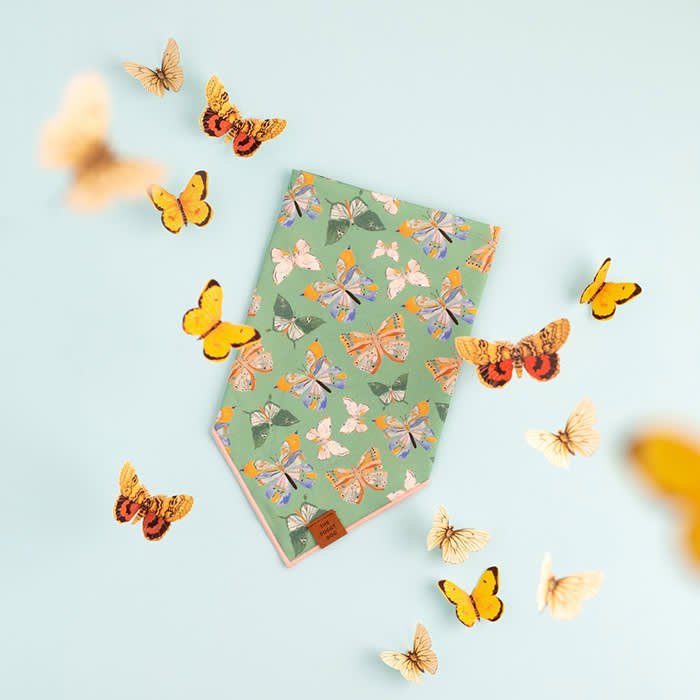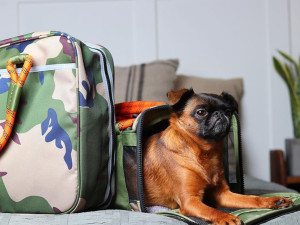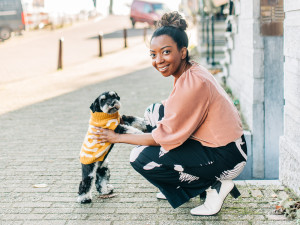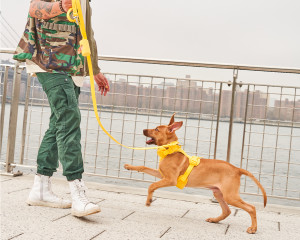The Foggy Dog Takes a Sunny Approach to Sustainability
Founder Rose Shattuck on her thoughtfully designed pet essentials and accessories — made locally and sustainably.
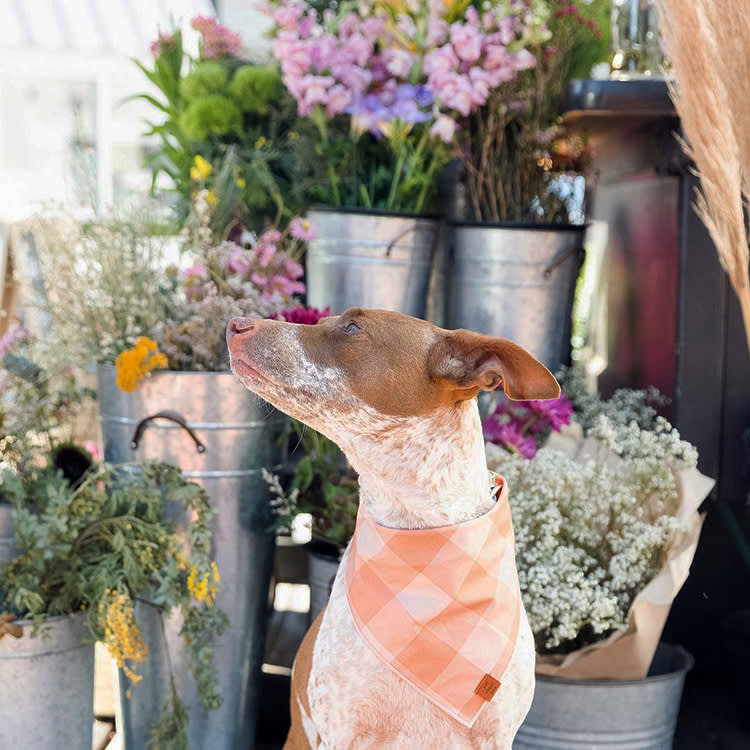
Share Article
There’s so much to love about The Foggy Dogopens in a new tab, the San Francisco-based pet product company founded by Stanford Business School graduate Rose Shattuck. Their products are thoughtfully designed and sustainably manufactured in small factories right here in the USA, many of them in and around San Francisco. The company even donates half a pound of food to a shelter for every purchase made (over 70,000 pounds in 2021 alone).
Of course, none of this would matter if the products they made weren’t beautiful, which they are. And playful. And cute. Sort of like Kate Spade in its heyday, back when Kate and Andy were still in charge. The fabrics, colors, prints, hardware — all-around beautiful, with just the right touch of whimsy.

littleKin™ is Kinship’s home just for puppy and kitten parents. Bop over to check out expert advice, new pet tools, and special deals—all curated for your newest family member.
opens in a new tabIn fact, The Foggy Dog’s products are so lovely that Shattuck often spots pet parents wearing accessories themselves. “[They] wear our bandanas as headscarves,” she says, noting that all of the company’s fabrics are “human-grade” and made of natural fibers, “so there’s no reason for people not to wear them.” The Foggy Dog has even started making masksopens in a new tab and scrunchiesopens in a new tab to match their best-selling bandanasopens in a new tab, collarsopens in a new tab, and dog bowsopens in a new tab.
Like many entrepreneurs working in the pet space today, Shattuck started her company after struggling to find attractive, quality products for her own dog, Utah. “I began by searching for the perfect dog bed,” she says. “But after scrolling through hundreds of options, I couldn’t find the one. So I hired a local seamstress to create the dog bed of my dreams.”
Shattuck realized she couldn’t be the only person hungering for modern, high-quality products for their dog, so she started buying fabric and set up an Etsy shop selling dog bed covers. Within three months, Anthropologie reached out and placed a wholesale order. “That’s when I knew I had a successful business on my hands,” she says. She dove in headfirst, quitting her job to devote herself full time to The Foggy Dog, and the business has been going strong ever since.
How did you come up with the name, The Foggy Dog?
It’s actually a nod to our San Francisco roots. My husband came up with it, back when the business was just a side hustle on Etsy, and it stuck.
What is your favorite product The Foggy Dog makes?
I particularly love our waste bag dispensersopens in a new tab. They are so cute and compact. Plus, I love how they make you feel stylish, even when you’re cleaning up after your dog.
I love that you use fabric scraps from your dog beds to make your squeaky toys. What other ways do you make sustainability a part of your brand?
One thing we’ve done from the start is to stuff our dog beds and dog squeak toys with filling that’s made from 100% recycled plastic water bottles, which would have otherwise ended up in landfills. Through that, we’ve been able to recycle over 500,000 plastic water bottles.
We also try to limit waste in the manufacturing process. For instance, we’re trying to move as much as possible to eco-friendly, digital printing options to limit wastewater production. We also operate minimum-waste manufacturing wherever possible. We ship with 100% recycled mailers and use minimal or zero plastic in our packaging and instead ship orders with cotton drawstring bags that can be re-used to hold your pup’s toys and treats.
You really seem to have embraced sustainability at every stage.
I didn’t know anything about the process of making sewn, textile-based products before starting The Foggy Dog. The more I’ve learned, the more it’s been a wake-up call. I was shocked to see the amount of fabric scraps wasted during the cutting process, and have since learned that every year, 26 billion pounds of textiles end up in landfills through a combination of production waste and discarded clothing. Plus, traditional textile manufacturing generates significant amounts of greenhouse gasses, uses a significant amount of water, and discharges hazardous chemicals into the environment.
Speaking of manufacturing, you are one of the few pet product companies that manufactures here in the US. Why is that so important to you?
I’m really passionate about supporting American manufacturing and creating a quality product that our customers can enjoy. All of our factories are small businesses, and most are family-owned. We work extremely closely with them and are on the phone with them nearly every day. I love being that close to how our products are being made and I’m proud that we are able to make our products in factories where people are paid sustainable wages. We have created 12 jobs at our main factory alone.
A lot of your factories are in and around San Francisco. Are there advantages to manufacturing locally, as opposed to overseas?
Absolutely! We can drive over to our factory and make product improvements in real-time together based on customer feedback. And because we don’t have long lead times with overseas shipping, we can be very nimble and reprioritize our production runs based on what is selling.
I also love that you donate half a pound of food to a shelter for every purchase made on your websiteopens in a new tab. Why is it important to you to give back in that particular way?
Not every dog is lucky enough to have a loving family. Giving back to rescue animals is a huge part of The Foggy Dog. I’ve been donating to the ASPCA ever since I was 12 years old and mailed them my first $15 check. When I started The Foggy Dog, I wanted to make it part of our mission to support animals in need.
You have your own dog, Utah. Does he ever come to work with you?
All the time! We like to call him “the boss.” He can be a bit grumpy and likes to make sure the other office dogs are having fun, but not too much fun!
Sounds like you have a lot of eager product testers on hand.
Yes, all of our office dogs and occasionally our brand ambassadors will help us test products. Utah was the inspiration for creating my first product, a dog bed, so you could say he’s the inspiration for the company as a whole!
What’s that development process like?
We get our best product ideas from our customers, and we are always listening to what they want. We try to find gaps in the market that we are uniquely positioned to address. Once we start to develop a new product we will iterate with our factories until it’s perfect, testing samples with our customers and office dogs. Then, once we launch, we continue to solicit feedback and make any adjustments needed to continually improve our products.
I primarily get inspired by listening to our customers and brand ambassadors. I also follow a lot of designers and artists in the home decor, textile, and stationery worlds, and I’m constantly thinking of ways to incorporate fresh new designs into our products.
You’ve done some great collaborations too. How do you choose who to work with?
I look for artists whose style is an aesthetic fit with our brand and whose work will resonate with our customers. And a lot of the artists we’ve collaborated with — like Rifle Paper Co. and Molly Hatch — I’ve been a personal fan of for years.
Who would you love to collaborate with that you haven’t already?
Interior designers like Caitlin Wilson, Studio McGee, Amber Lewis and Anna Spiro, and artists like Rebecca Atwood, Justina Blakeney, and Pencil and Paper Co. — whom I have personally followed and admired for years.
Is there anything you wish you could tell your younger self when you first started doing this?
That’s an easy one: get help sooner! I was very stubborn and cost-conscious (read: cheap) at the beginning, and tried to do everything by myself. I didn’t hire any full-time employees until we were over a million dollars in revenue, so I was the one packaging and shipping orders, doing customer service, managing our Instagram, working with the factories, sending marketing emails, etc., etc. I have since hired an incredible and talented team and have seen the benefit of having help!
Do you remember the first time you saw one of your products out in the wild?
Of course! I saw a woman walking her dog down a street in San Francisco with one of our marine rope leashesopens in a new tab and waste bag holdersopens in a new tab. I was so excited that I ran over and introduced myself. She was very gracious about this random person running over to talk to her and told me that she and her dog loved our products and had a lot of our bandanasopens in a new tab and collarsopens in a new tab too, which was so thrilling to hear. It never gets old, seeing our products out in the wild!
What’s next for The Foggy Dog?
There is a lot happening this year! We are launching harnesses, our most-requested product that has taken us three years to perfect. We’re also super excited about a couple of new collections launching soon, including a fun, beachy summer collection!
* This interview has been edited for clarity and brevity.
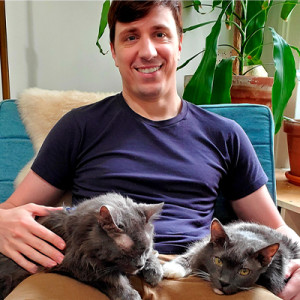
Charles Manning
Charles Manning is an actor, writer, and fashion/media consultant living in New York City with his two cats, Pumpkin and Bear. Follow him on Instagram @charlesemanningopens in a new tab.
Related articles
![Dog sitting in their small size pet carrier]() opens in a new tab
opens in a new tabBehind the Brand: Roverlund
Vogue alum Jamies Knowles has elevated the pet carrier to a fashion-forward accessory.
![Sir Dogwood]() opens in a new tab
opens in a new tabWant to Up Your Dog’s Style Game? Sir Dogwood Has You Covered
The online boutique’s founder on the importance of supporting BIPOC-led pet brands.
![]() opens in a new tab
opens in a new tabBehind the Brand: Wild One
Co-founder Minali Chatani on well-designed dog gear, supporting local rescues, and the secret to snapping the perfect pic.
![Dog wearing a collar and leash by the company Dog + Bone]() opens in a new tab
opens in a new tabBehind the Brand: Dog + Bone
A company set out to prove that not all collars are created equal.
